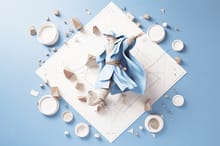How to Measure Design Service Effectiveness?

- #Design Service
- #Effectiveness Metrics
• 6 min read
This year, our design team is focusing on enhancing efficiency, streamlining processes, and investing in analytics — primarily, how to measure our effectiveness.
Some context about our team
Our design team operates as a service unit within MacPaw: we complete tasks for numerous teams within the company. Considering this context, it's crucial for us to adapt to the conditions set by our internal clients. This includes adhering to deadlines determined by these clients and maintaining maximum flexibility throughout our workflow.
Hence, as part of our strategic initiative, we embarked on a mission to establish metrics that would effectively display our performance.
What do metrics mean for our team?
Metrics are pieces of quantitative and qualitative data to assess team effectiveness.
In our design team, we envisioned they would help us understand our standing, highlighting areas for development. The idea was to use metrics to critically look at our work and its impact on the client and the company. Another crucial goal was to improve the existing processes both within the team and in interactions with other teams within the company, all based on analytics.
What do metrics mean for me?
As a Design Service Manager, I continually ponder over the key question: “How can we cultivate a successful team that maximizes value for business?”
To provide objective responses to these questions, I must stand on firm ground—hence, the indispensable need for well-defined metrics.
Don’t get me wrong, our life before metrics was not pure chaos. The specifics of our work would remain largely unchanged, and I don’t envision a complete overhaul as the goal. Alternatively, my goal is to have reliable data for evaluation and improvement.
How to choose the right metrics?
Gathering ideas
First, we held a team-wide brainstorming where everyone defined their understanding of these questions:
- How do we know we are effective as a team?
- How does the client understand that we are a team that can be trusted and will return to us again for expertise?
- What do team performance metrics mean for us?
After the session, I gathered dozens of stickers with thoughts on this topic, and it was a complete mess to tell you the truth. So I began to think about how to turn people’s inputs into real metrics.
Filtering ideas
First, I filtered through all the answers using the SMART criteria. Our metrics must be Specific, Measurable, Attainable, Relevant, and Timely.
Next, I returned to the entries on the stickers and tried to categorize them. In the end, I divided entries into these three buckets:
- Interaction with the client – all issues related to interaction with other teams.
- Task/project flow – all issues related to the work itself.
- Team atmosphere – how our designers feel.
After that, I summarized the questions and created working metrics for each direction, keeping in mind the SMART criteria.
As a result, I have formulated the following ready-to-go metrics: Flow Efficiency, Client Satisfaction, and Team Health.
Flow Efficiency
The flow of our projects/tasks is a collection of different stages of work and processes:
- Active when design work is taking place.
- Idle when the team is in the waiting stage.
Measuring the time we need for active work will allow us to understand in the future how much time any task takes. At the same time, measuring the time of idle stages gives us room to improve processes internally and externally, because we can influence some of them.

Surprising Discovery: While tuning our Flow Efficiency, we clocked some mundane tasks that, on the surface, should take no longer than 20 minutes. However, they shockingly ended up devouring several hours due to their unique intricacies. They stealthily consumed our productive hours, but now we are aware of such tasks.
How to measure Flow Efficiency?
I have divided the tasks into different categories that occur in our team: routine, creative, and projects.

Routine. Routine tasks are those that follow a well-defined pattern. We want to measure how much time we spend on these tasks and see if we can notice any unnecessary repetitions. The goal is to optimize the routine to free up time for creative and long-term projects.
Creative. Creative tasks are the holy-grail of design. They require several iterations as well as additional research, storming, or sketching. We want to measure how long they take to make better, albeit still approximate, estimations in the future.
Projects. Projects are large-scope tasks that also require non-design activities: communication with other departments, many iterations, involvement of more than 1-2 team members.
We differentiate between different design and non-design activities, measuring how much time each takes. We want to increase productivity of our service unit, and for that we need to understand what exactly is delayed.

Example: Suppose we put in 1 week of work on a project that took us 2 weeks to complete. The activity phase in this flow is 50%. 5 days work / (5 days work + 5 days wait) * 100% = 50% Having measured active and passive states, we know that our designers sat idle for a half of the project’s duration. Now, the data serves as a call to do something about it.
Client Satisfaction
As a design service provider, we interact with different teams. So, it is important for us to understand that we are really helping the client solve the problem they face with high-quality designs, while involving our expertise to influence brand awareness. That is why customer feedback is important to us.

How to measure Client Satisfaction?
The plan is to send short questionnaires to clients asking them to leave feedback on interaction with the team.

This is a 5-point rating scale where clients share their perception of the following factors:
- overall satisfaction with the interaction
- quality of design services
- response to requests/edits
- communication with the team
- compliance with deadlines
Team Health
It is impossible to build an effective team without the right atmosphere within the team. After all, it is important for designers to feel in an atmosphere of trust, to be inspired, to be creative, to develop their competencies and to feel an impact on the development of the company. That’s why I have included Team Health as a separate metric.

How to measure Team Health?
I’ll be requesting team’s feedback twice a year on the following issues:
- Psychological Safety
- Dependability
- Structure & Clarity
- Meaning
- Impact
Conclusions
From my personal experience, creating metrics for a creative team is challenging. However, I firmly believe we are on the right path. Having ready-to-use analytics on flow efficiency, client satisfaction, and team health will help us become even more helpful!
The next step in this process is to measure each metric at varied intervals and implement changes. Stay tuned to follow our story and read about the latest developments at MacPaw Design Service.





